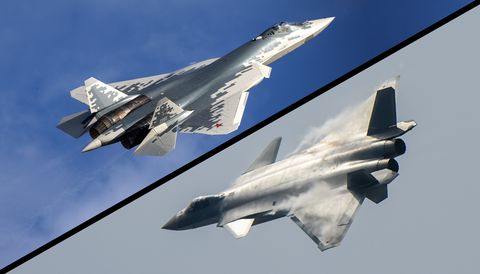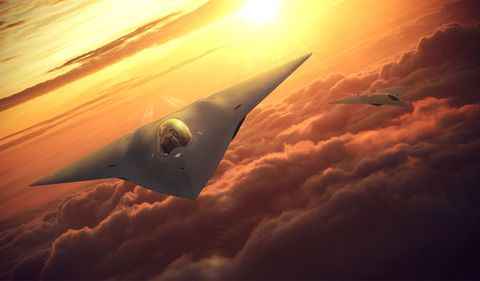Russia’s Sukhoi Su-57 Felon (left) and China’s Chengdu J-20 Mighty Dragon (right)
Getty Images
In 1909, the United States introduced the concept of military aviation to the world with the purchase of its first Wright Military Flyer. A decade later American and Allied pilots found themselves squaring off against aviators from the German Empire over the Western Front in the first battles for air dominance.
But like maintaining any technological edge over your opponents, air superiority is never guaranteed. The only way to keep the advantage is to continue to outpace, outbuild, and outfox the competition. Now, the next step in that race is beginning to take shape.
In September, the U.S. Air Force announced that it had secretly designed, built, and tested a prototype fighter under its Next Generation Air Dominance (NGAD) program. Details regarding the new fighter remain sparse, but the program’s nature does offer a few important bits of context.
The NGAD program aims to develop the next generation of air superiority fighter, which places its technological lineage in the realm of the legendary F-15 Eagle and America’s premier intercept fighter, the F-22 Raptor. While experts continue to mull over what capabilities might be required of the first 6th generation fighter, some answers could be gleaned by checking out its competition: Russia’s Sukhoi Su-57 Felon and China’s Chengdu J-20 Mighty Dragon.
New Fearsome Fighters
The U.S. introduced stealth to the world with the F-117 Nighthawk, and for decades enjoyed a monopoly on low observable platforms. Lockheed Martin, the firm that designed and built the F-117, would go on to establish the fifth generation of fighters with the F-22 Raptor, the world’s first air superiority fighter designed from the ground up with stealth in mind. Initially, the U.S. planned to order 750 of these new stealth fighters, but shifting priorities and lower budgets ultimately left the program dead after just 186 were built.
The F-35 would eventually come to utilize a great deal of the F-22’s supply chain when it entered production, ensuring the U.S. would never see another F-22 roll off the assembly line.
With both the F-22 and F-35 in its stable, the U.S. still holds the largest fleet of stealth fighters in the world, but with Russia’s Su-57 and China’s J-20 both currently in production and already deemed operational, the U.S.’s days of having a monopoly on stealth fighters has officially come to a close. These fighters represent the most technologically advanced and capable platforms in Chinese and Russian arsenals.
These adversaries also offer an important glimpse into what America’s next jet will need to beat.
Stealth
One of the most significant technological developments that separates fifth-generation fighters from what’s come before is stealth design. While some fourth-generation fighters leverage things like radar-absorbent coating to delay detection, fighters like the Su-57 and J-20 were designed with stealth in mind from the ground up.
Stealth isn’t a single technology, but rather a series of overlapping technologies, production methodologies, and combat tactics used to limit or impede detection from enemy weapons systems. Stealth isn’t about making an aircraft invisible, so much as making it survivable in highly contested airspace.

Su-57 Felon
Widely considered to be the least stealthy of the world’s fifth-generation competitors, the Su-57 Felon likely trails behind the J-20 in terms of observability—but that could be by design. The F-117 Nighthawk marked America’s transition away from the Cold War priorities of faster and higher-flying jets. Instead, new and costly technologies would defeat air defenses by avoiding detection altogether. Russia’s troubled economy and aging industrial infrastructure may be limiting the nation’s ability to develop the material science and tight production tolerances required of a truly “stealth” fighter.
“I would handicap the Su-57 as something between an International Roadmap Super Hornet or Silent Eagle and China’s J-20, with it being closer to the former than the latter,” aviation analyst Tyler Rogoway explained.
But recent images of the second production Su-57 in progress suggests that production tolerances have improved over the dozen previous fighters to roll out of Russia’s Komsomolsk-on-Amur Aircraft Plant.
“The tolerances on the skin panels here are significantly better than what we saw on the 11 pre-production aircraft,” Aviation Week defense editor Steve Trimble said upon the release of Russia’s second production Su-57.
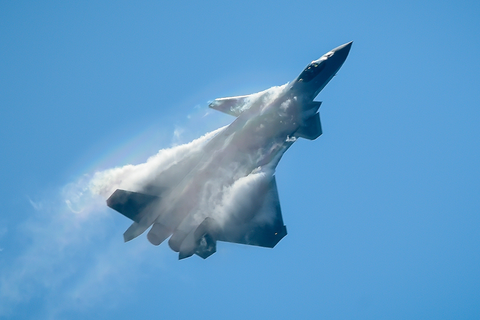
J-20 Mighty Dragon
While there remains some debate about how stealth China’s J-20 truly is, it is still believed to be more difficult to detect than its Russian competition. As is the case with the Su-57, experts can only speculate about the makeup and capability of the radar-absorbent materials coating on these fighters.
The J-20 was heavily influenced by stolen design schematics for America’s F-22 Raptor, though there are some clear differences between the two aircraft. The J-20’s front canards were initially thought to be a detriment to the aircraft’s stealth profile, but computer modeling would seem to suggest that the J-20 is likely extremely difficult to detect when approaching head-on and could further improve its stealth profile as the program matures.
“If the production J-20 introduces a rectangular faceted nozzle design, and refinements to fuselage side shaping, the design would present very good potential for robust Very Low Observable performance in the S-band and above,” wrote Dr. Michael J. Pelosi and Dr. Carlo Copp in an in-depth 3D modeling study of the fighter.
S-band and higher radar frequencies are used to capture a weapons-grade lock on an aircraft.
Avionics
While stealth is the most commonly discussed aspect of fifth-generation fighters, their leap in avionics systems offers a similarly significant advantage.
The F-35 Joint Strike Fighter is often referred to as a “quarterback in the sky” by pilots for good reason: The aircraft is effectively a flying supercomputer designed to take in data from numerous disparate sources and combine it into a single, easy to manage, user interface. While America may have the lead in fifth-generation avionics, both Russia and China have placed a significant emphasis on this technology in the development of the Felon and Mighty Dragon.

Su-57 Felon
Russia’s Su-57, like America’s F-35, is capable of exchanging data with other nearby aircraft and ground assets, which it couples with existing intelligence about known targets to offer a streamlined understanding of the battle space.
“The avionics on the Su-57 fighter is based on the entirely new architecture, which, to date, has never been used in Russian military aviation,” explained Dmitry Gribov, a chief designer of the Su-57’s onboard systems. “It is operated on the concept of network-centricity, which involves a consistent upgrading of onboard systems and operating complexes of the aircraft. The multi-core base of the complex provides almost unlimited possibilities.
“The Su-57 also boasts side-facing radars that work in conjunction with its nose-mounted X-Band N036 Byelka (Squirrel) AESA radar system. These cheek-mounted radars offer the Su-57 an extremely wide field of view and dramatically enhances the pilot’s situational awareness.”
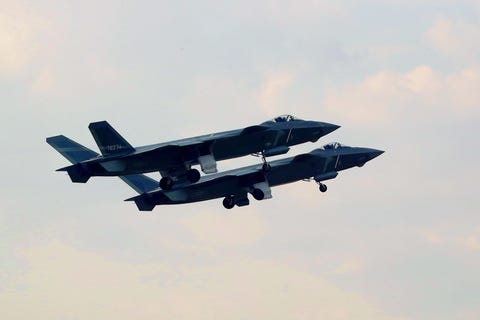
J-20 Mighty Dragon
The J-20, like the Su-57 and other fifth-generation competitors, is believed to leverage a secure data link for advanced communications and data transmission between it and other aircraft and nearby ground assets.
The J-20 also boasts a chin mounted infrared/electro-optic search-and-track sensor and a passive electro-optical detection system that offers the pilot a high degree of situational awareness of everything going on around the aircraft in a 360-degree sphere. These systems are rumored to be advanced enough to be on par with the advanced systems employed by the F-35, the U.S.’s “quarterback in the sky.”
Onboard systems combine radar information with infrared imaging to offer the pilot an integrated view of the battle space via holographic heads-up display and LCD touch screens. The primary screen in the J-20’s cockpit is 24 inches by 9 inches with three smaller auxiliary displays.
Armament
All the stealth and avionics tech in the world can’t win a fight without weapons, though total armament is one area where new jet platforms lag behind their predecessors. In order to maintain a stealth profile, these fighters have to carry weapons internally, limiting their total payload capacity.
But these fighters do offer external hardpoints for mounting extra weaponry in uncontested airspace. If stealth isn’t a factor, each of these fighters can carry far more firepower into the fight, but because both Russia and China maintain large fleets of highly capable fourth-generation fighters, these fighters will likely be leveraged primarily in operations where maintaining a low profile is preferred.

Su-57 Felon
Like the competition, the Su-57 carries its weapons internally to maintain a minimal radar profile. Details remain fairly limited regarding the Su-57’s armament, but there are a few things we can assess for certain. The Felon leverages a unique internal weapons bay configuration that can likely support between four and six medium-range air-to-air missiles. Two secondary weapons bays can also be found in triangular structures located under the fighter’s wing roots that open like clamshells to reveal short-range air-to-air missiles. Thus far, no images or footage of these unique secondary bays in use have surfaced.
The aircraft also boasts six external hardpoints for carrying extra munitions when stealth isn’t a concern.
The Su-57 employs a single 30mm Gryazev-Shipunov GSh-30-1 autocannon for close-range engagements. While the Su-57 is Russia’s most advanced fighter, its cannon has actually been in service since 1980. With a firing rate of 1,800 rounds per minute and incendiary armor-piercing projectiles, this weapon can be deadly at an air-to-air range of 800 meters and an air-to-ground range of more than 1,800.
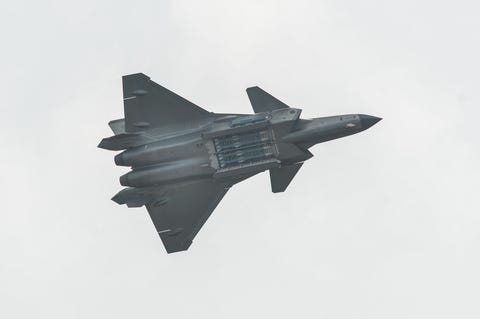
J-20 Mighty Dragon
The J-20 goes about hiding its weapons from radar slightly differently than the Su-57, utilizing one large primary bay for a variety of missiles and bombs often meant for air-to-surface engagements, as well as two smaller lateral bays used specifically for air-to-air weapons. The lateral bays allow the J-20 to keep its primary weapons bay closed while engaging other fighters, minimizing the jet’s radar signature even while it engages airborne opponents.
But the J-20 was not designed for close-up dogfighting and was instead intended to engage enemy aircraft from longer ranges. As such, the aircraft has no cannon whatsoever, making it the only fifth-generation fighter in service anywhere in the world that has opted to forgo the guns.
When stealth isn’t a concern, the J-20 also boasts four additional external hardpoints beneath its wings. In total, the aircraft can carry four weapons in its primary internal bay, one in each lateral bay, and four externally.
Credit: emperornie/Flickr (CC Attribution-ShareAlike 2.0)
Maneuverability
Just how important maneuverability will be for this generation of fighters remains unclear. Some experts believe the era of dogfighting ended as soon as advanced fighters began carrying missiles that could engage targets from beyond the horizon. But others say that the conventional wisdom of our day is based on small wars against technologically inferior opponents. That means we can’t reliably predict what a superpower war would look like.
The closer fighters are to one another when they engage, the more acrobatic they need to be to win, but from long distances, avionics and weapon performance become a more significant advantage. These two approaches to air combat seem to be on display in the Su-57 and J-20, with the Russian fighter apparently built for close up dogfights and the Chinese jet favoring long distance engagements.
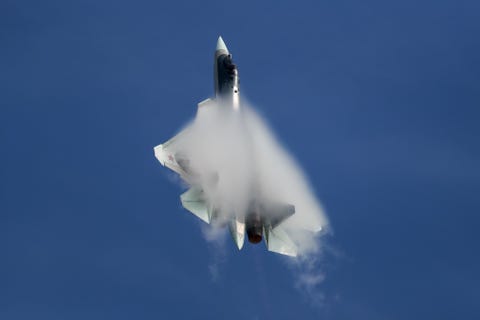
Su-57 Felon
While Russia may struggle with the tight production tolerances required of a stealth airframe, there’s no denying the nation’s knack for developing highly maneuverable fighters. Like the acrobatic fourth-generation Su-35, the Su-57 utilizes 3D thrust vectoring controls that allow the aircraft a great deal of maneuverability at high speeds and altitudes.
Thrust vector controls allow the pilot to direct the outflow of thrust from the engines independent of the direction the aircraft itself is pointed. This allows the Su-57 to execute dramatic rolls and loops at low speeds, though doing so scrubs a great deal of the aircraft’s momentum and may leave it susceptible to attack from other nearby fighters. As such, thrust vector controls would most likely be leveraged for attacks at high altitudes and speeds. It can orient the fighter’s nose down toward enemy aircraft while its engines’ outlets keep it traveling in a forward direction.
While the F-22 Raptor also utilizes some degree of thrust vectoring, the Su-57 is the only stealth fighter on the planet to incorporate 3D (or omnidirectional) thrust vector control.

J-20 Mighty Dragon
The first J-20s in service to China’s air force did not incorporate thrust vector controls, but China announced that their latest iteration of the fighter, the J-20B, will include the capability. Some experts think that the J-20’s length and aerodynamic profile make it poorly suited for the sort of acrobatics required of an air superiority fighter, but reports out of China seem to suggest that it’s not as clumsy as some experts may believe.
J-20 test pilots have been quoted as saying that the aircraft was comparable in agility to China’s acrobatic fourth-generation fighter, the J-10. Another analysis from Chinese aerospace engineer Dr. Song Wencong also suggested that the jet would be more agile than what many experts predict.
But simply saying the aircraft is highly maneuverable isn’t the same as building a highly maneuverable aircraft, so the J-20’s acrobatic chops remain in question.
Overall Performance
While it can be informative to analyze the different specific aspects of a fighter, it’s the way these systems complement one another that really determines overall capability.
Because neither of these jets have seen actual combat yet, assessing their overall performance is a bit of a guessing game, but there are certainly some conclusions we can draw from unclassified data regarding each. Fighters in the fifth-generation are expected to serve as multi-role platforms capable of both air-to-air and air-to-ground operations, but the broader the mission set required of an aircraft, the less capable it becomes in each.
That means both the Su-57 and J-20 may be tasked with similar operations, but they each seem to specialize in slightly different areas.
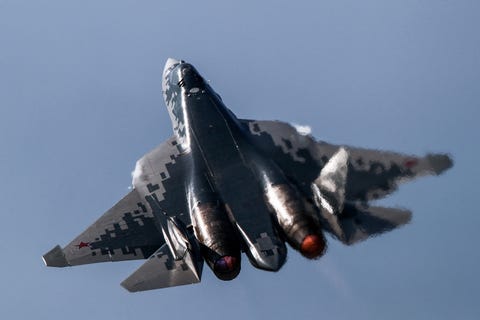
Su-57 Felon
While some may question the Su-57’s stealth, there is little doubt that the aircraft itself is a solid performer. The Su-57 is expected to field new Izdeliye 30 engines in the future, but even with the less powerful AL-41F turbojet engines that current Felons operate, the fighter is capable of speeds in excess of Mach 2, with a service ceiling of 66,000 feet, and a rate of climb of 1,180 feet per second.
Its powerful engines combined with thrust vector controls make the Su-57 both a speedy and an acrobatic adversary. While exact figures regarding the fighter’s range vary depending on the source, it is believed that the Su-57 has a supersonic range of more than 900 miles, or 1,900 miles while traveling at subsonic speeds and carrying external fuel tanks.
The Su-57 also boasts directional infrared countermeasure systems that use laser turrets to blind incoming infrared missiles, and the fighter jet was designed with robust enough landing gear to utilize austere and poorly developed airfields.
All told, the Su-57 may not be the best fifth-generation fighter on the block, but does appear to be a well balanced and capable aircraft that would be a fierce opponent for nearly any fighter in the sky.

J-20 Mighty Dragon
When compared to the Su-57, the J-20 looks pretty good on paper. While China is also struggling with developing a tailor-made engine for its fifth-generation fighter, J-20s operating Russian-designed AL-31 engines still boast an impressive top speed of Mach 2.55. Intended to serve as a long range interceptor, the J-20 is believed to have a range of more than 1,600 miles, placing it well ahead of its Russian competition.
Like the Su-57, the J-20 tops out at around 66,000 feet, but it will get there a bit slower than the Felon thanks to a climb rate of just below 1,000 feet per second.
Despite being faster and having a longer range, concerns about the J-20’s agility would likely place it behind the Su-57 in terms of close-range dogfighting capabilities, as does its lack of onboard cannon. But defense experts don’t agree on how practical close range dogfighting really is in the 21st century, so it’s difficult to say if the decision to omit the cannon will come back to haunt the Mighty Dragon.
U.S.’s Next Fighter: Help From (Robot) Friends
An illustration of Lockheed Martin’s Next Generation Air Dominance fighter.
Lockheed Martin
Like its air superiority predecessors, the F-22 Raptor was designed from the ground up to dominate the skies, but politics and economics forced the cancellation of the program after only 186 were made.
Today, some estimates place the number of combat-ready F-22’s as low as just 33 at any given time. With China’s J-20 and Russia’s Su-57 already in service and moving toward higher volume production, it makes sense that the U.S. is moving quickly to develop the next generation of air superiority fighter, and in keeping with America’s aviation lineage, it will likely aim to leapfrog past the advanced capabilities of both Russia and China’s top tier jets.
While stealth technologies will continue to mature, the next generation American air superiority fighter will likely see huge leaps in avionics and data fusion. F-35 pilots stand head and shoulders above the competition in terms of situational awareness thanks to the aircraft’s ability to receive and streamline data from multiple sources into a single interface. The next iteration of this technology will almost certainly see the addition of unmanned drones operating in support of crewed fighters to extend sensor range, increase their weapons magazine, and even protect the pilot. This effort is already underway in programs like the Air Force’s Skyborg initiative and Boeing’s Loyal Wingman program.
In order to support the rapid advancement of these technologies, America’s next generation fighter will likely have to leverage a more modular design than previous jets, which will allow avionics systems, weapons, and other hardware on the aircraft to be easily removed and replaced with newer, more capable systems as they’re developed. As a result of both of these changes, the next fighter will also need to roll off the assembly line with a fair amount of surplus power to support not just the most advanced systems the U.S. has to offer today, but importantly, also the directed energy weapons of the coming decades.
Currently, the Air Force aims to begin arming fighters with laser weapons by 2025.
The Chengdu J-20 and Sukhoi Su-57 don’t just represent the best of their respective Air Forces, they also represent the end of America’s monopoly on stealth fighters. To put it simply, the NGAD program has its work cut out for it.

